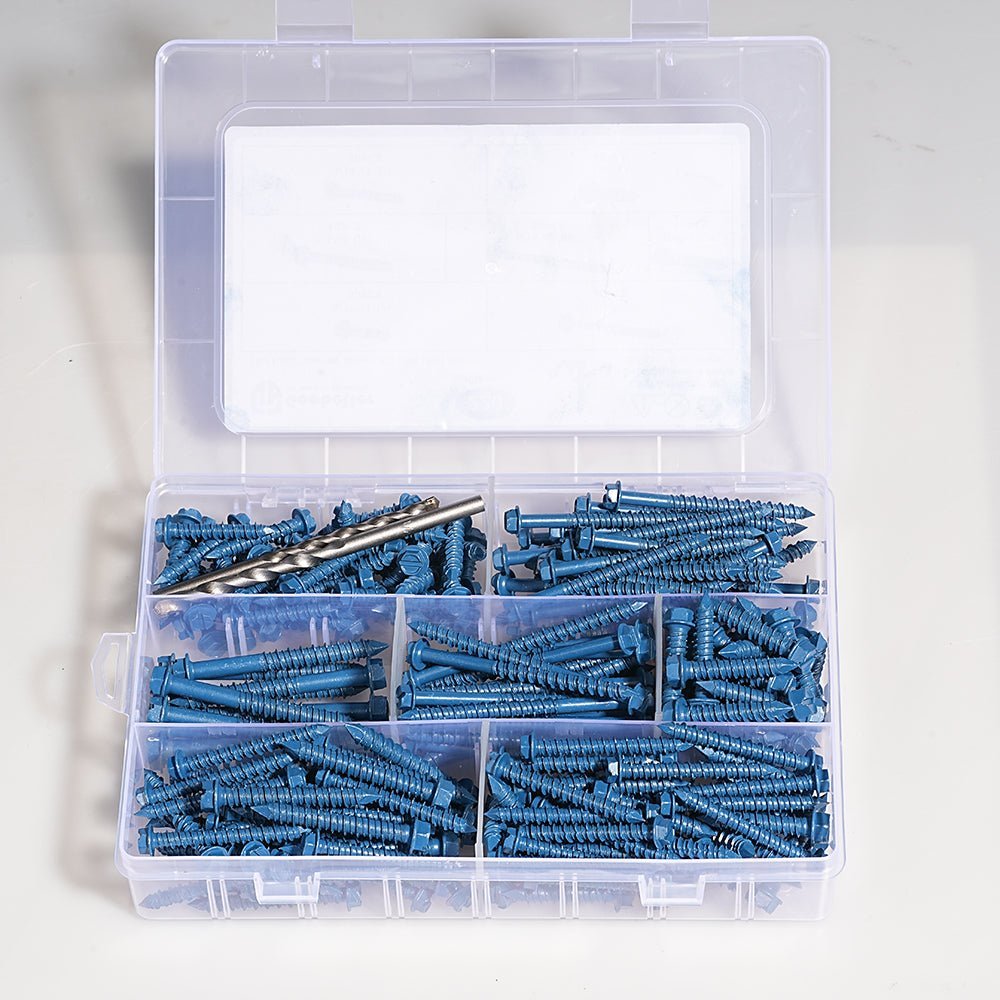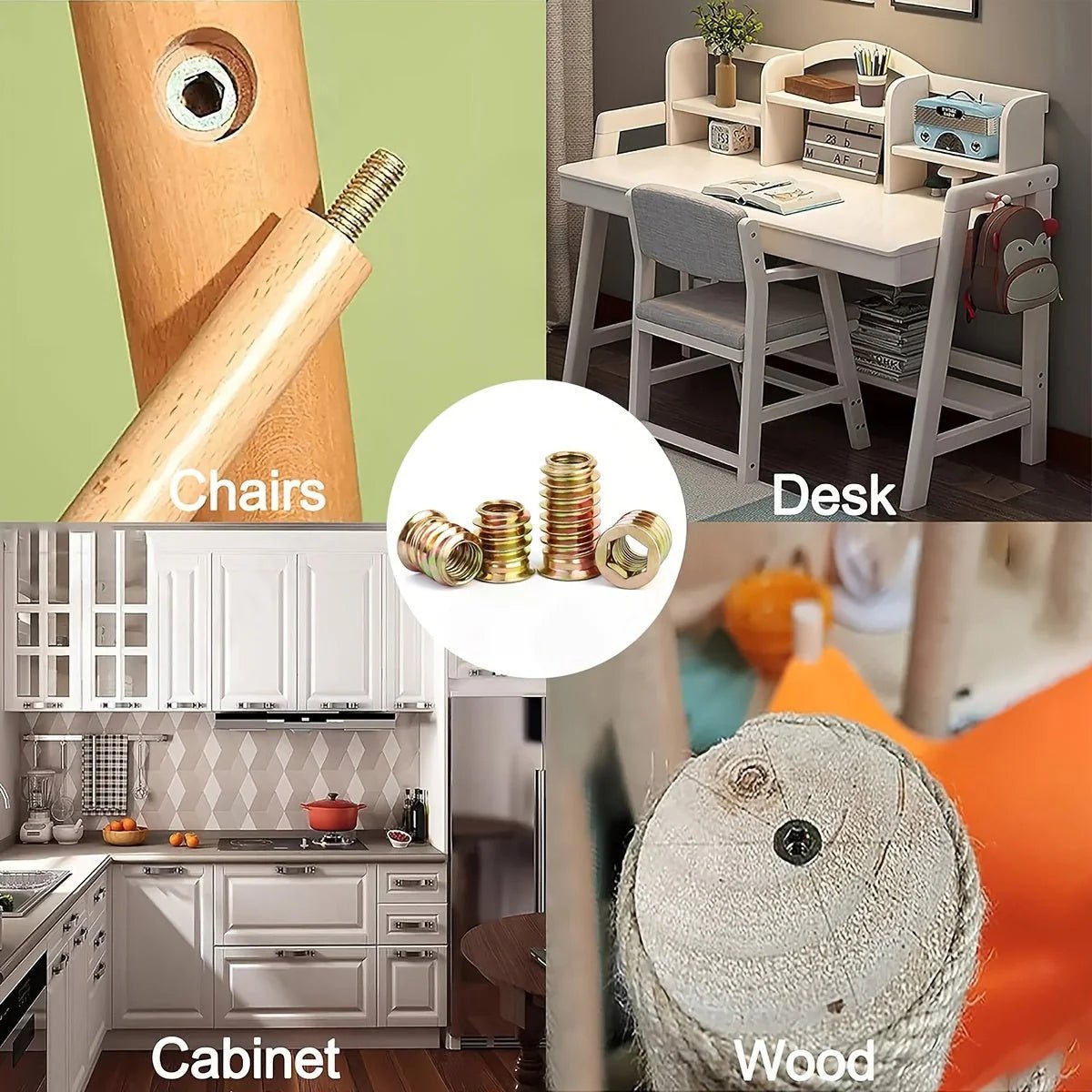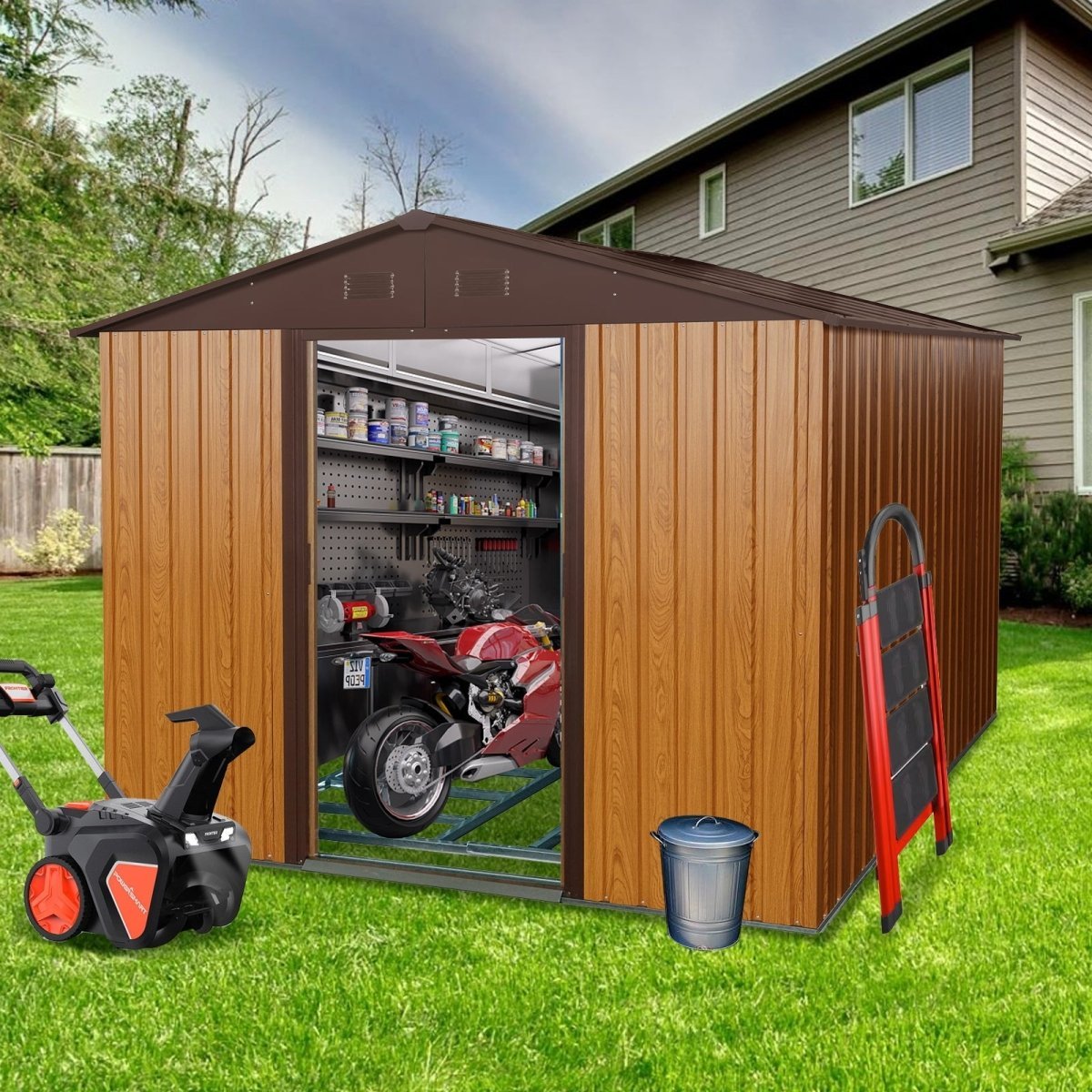Table of Contents
-
Why Anchors Matter: The Silent Heroes of Your DIY Projects
-
Anchor Basics: How Do They Actually Work in Concrete?
-
The Contenders: Common Types of Concrete Anchors
-
Deep Dive: Concrete Screws vs. The Competition
-
Why Concrete Screws (Like Blue Ruspert) Are Often the BEST Choice
-
Installing Concrete Screws Like a Pro: A Step-by-Step Guide
-
The Blue Ruspert Advantage: More Than Just Screws & a Bit
-
Choosing the Right Anchor: It's Not One-Size-Fits-All
-
FAQs: Your Concrete Anchor Questions Answered
-
The Final Verdict: Securing Your Success
1. Why Anchors Matter: The Silent Heroes of Your DIY Projects
Let's be honest, anchors aren't the glamorous part of DIY. You don't brag about the amazing anchor you used behind that gorgeous floating shelf. But here's the unvarnished truth: that anchor is the silent, sweaty hero holding your entire project together. Choose wrong, or install it poorly, and your masterpiece becomes a hazard – a shelf crashing down, a railing pulling loose, a TV mounting becoming a very expensive floor decoration.
Concrete, brick, and block are tough customers. Unlike wood, you can't just drive a screw straight in and expect it to hold significant weight. The material is hard, brittle, and lacks fibres for a screw to bite into. That's where anchors come in. They create a secure, mechanical lock within the base material, transforming a simple hole into a load-bearing connection point. Ignore their importance at your peril – and potentially your drywall's peril too!
2. Anchor Basics: How Do They Actually Work in Concrete?
Think of concrete anchors as clever expansion devices or specialized grips. Their core mission is to distribute the load (the force pulling or shearing your fixture) over a larger area inside the concrete, far exceeding what the screw threads alone could manage against the hard surface. Here’s the breakdown:
-
The Hole: Precision-drilled (diameter and depth are CRITICAL) using a masonry bit, usually carbide-tipped.
-
The Mechanism:
-
Expansion: Many anchors (plastic plugs, sleeve anchors, some drop-ins) expand when the screw is tightened or a setting tool is used. This expansion pushes outward against the walls of the hole, creating immense friction and mechanical lock. Imagine a wedge being driven in.
-
Thread Engagement: Concrete screws (like Tapcons or our Blue Ruspert screws) cut their own mating threads directly into the concrete as they're driven in. It's like the concrete becomes a giant, incredibly hard nut. The hardened steel threads bite and hold.
-
-
The Grip: This expansion or threading creates a powerful holding force that resists being pulled straight out (pull-out strength) or sheared sideways (shear strength). Good installation ensures this grip is maximized.
Key Factors Influencing Hold:
-
Concrete Strength: Harder, cured concrete provides a better base than soft or green concrete.
-
Hole Diameter & Depth: Too big = weak expansion. Too small = impossible install or cracked concrete. Too shallow = insufficient grip depth.
-
Edge Distance & Spacing: Anchors too close to the edge of the concrete or too close together can cause cracking and catastrophic failure.
-
Correct Installation: Clean holes, proper torque, using the right tools. Garbage in, garbage out!
3. The Contenders: Common Types of Concrete Anchors
The hardware store aisle can be overwhelming. Let's meet the players vying for the title of "Best Anchor for Concrete Screws" (spoiler: concrete screws are the screw! But we compare their system to others):
-
The Plastic Plug (Wall Plug / Rawlplug):
-
What it is: A sleeve (nylon, polyethylene) inserted into a drilled hole. The screw threads into the plug, causing it to expand.
-
Pros: Cheap, readily available, simple for very light loads (pictures, small hooks).
-
Cons: Very limited holding power in true concrete (better suited for brick/block). Prone to spinning in the hole when tightening. Can crack or strip easily. Useless if hole is slightly oversize. Not suitable for anything beyond trivial loads in solid concrete.
-
Best For: Plasterboard, light-duty in brick/block. Avoid for serious concrete work.
-
-
The Hammer-Drive Anchor (Nail-In Anchor):
-
What it is: A pre-assembled anchor (sleeve + pin/nail). Inserted into hole, then the centre pin is hammered flush, expanding the sleeve.
-
Pros: Relatively quick installation (just hammering), inexpensive.
-
Cons: Expansion is often uneven. Holding power is moderate at best. Hard to remove. Hammering can crack brittle concrete near edges. Setting depth is critical and tricky. Vibration can loosen it over time.
-
Best For: Light-to-medium static loads (electrical boxes, conduit clamps) where vibration isn't a factor, and edges are sufficient.
-
-
The Sleeve Anchor (Lag Shield / Expansion Anchor):
-
What it is: A threaded bolt surrounded by an expansion sleeve. Inserted into hole, then tightening the nut draws the bolt up, forcing the sleeve to expand.
-
Pros: Good, reliable holding power for medium-heavy loads. Wide range of sizes and head types (hex, flat). Removable (loosen nut to collapse sleeve).
-
Cons: Requires precise hole depth (sleeve must be below surface). Installation needs wrench access to tighten nut after fixture is placed (can be awkward). More expensive than plugs/hammer-drives. Oversize hole drastically reduces strength.
-
Best For: Securing machinery, structural connections, heavier fixtures where wrench access is possible.
-
-
The Drop-In Anchor (Internal Expansion):
-
What it is: A pre-inserted, internally threaded sleeve. Set using a setting tool that expands it from the inside as you hammer the tool. Then a bolt (machine thread) screws into the set anchor.
-
Pros: Provides a flush, threaded socket in the concrete. Excellent for heavy-duty applications where a bolt is preferred over a screw head. Very high pull-out strength when set correctly.
-
Cons: Requires a special setting tool. Setting depth is absolutely critical and must be precise. More complex installation. Permanent (very hard to remove). Significantly more expensive.
-
Best For: High-load structural steel connections, securing columns, heavy equipment bases – typically professional/commercial use.
-
-
The Concrete Screw (Tapcon, Blue Ruspert, etc.):
-
What it is: A specially hardened screw with unique, aggressive threads designed to cut their own mating threads directly into the concrete as they're driven in. No separate plug or sleeve needed! Often paired with a specific carbide drill bit.
-
Pros: Extremely high holding power relative to size. Fast installation (drill hole, blow out dust, drive screw). No expansion stress during install (less risk of cracking near edges). Removable and reusable. Can be installed flush. Works well near edges. Kits (like Blue Ruspert) include the perfectly sized drill bit.
-
Cons: Requires a hammer drill for efficient hole drilling in hard concrete. Hole diameter must match screw size precisely. Threads can strip if over-torqued or hole is too big. Not ideal for extremely high shear loads where a bolt-type anchor might be better.
-
Best For: The vast majority of DIY and prosumer projects: Framing (sill plates), deck posts, heavy shelving, TV mounts, stair railings, exterior fixtures, HVAC units, electrical panels, plywood to concrete, and much more. The ultimate all-rounder.
-
The Quick Comparison: Concrete Anchors Showdown
| Feature | Plastic Plug | Hammer-Drive | Sleeve Anchor | Drop-In Anchor | Concrete Screw (e.g., Blue Ruspert) |
|---|---|---|---|---|---|
| Holding Power | Very Low | Low-Medium | Medium-High | Very High | High-Very High |
| Ease of Install | Very Easy | Easy | Moderate | Complex (Needs Tool) | Very Easy |
| Speed | Fast | Fast | Moderate | Slow | Fast |
| Removable? | Sometimes | Difficult | Yes (Loosen Nut) | Very Difficult | Yes |
| Edge Distance | Moderate | Poor | Good | Good | Excellent |
| Vibration Res. | Poor | Poor | Good | Excellent | Good-Excellent |
| Cost | $ | $ | $$ | $$$ | $$ |
| DIY Friendliness | High (Light Duty) | Medium | Medium | Low | High |
| Best Use Case | Pictures, tiny hooks | Light fixtures, boxes | Medium fixtures, machinery | Heavy structural | Framing, Shelving, Railings, Fixtures (Most DIY/Prosumer) |
4. Deep Dive: Concrete Screws vs. The Competition - Why They Shine
Concrete screws aren't just another option; they represent a significant leap in convenience, versatility, and performance for most users. Let's break down their winning advantages:
-
Unmatched Simplicity & Speed: Drill the hole. Clean the hole (CRUCIAL!). Drive the screw. Done. No fiddling with separate plugs, sleeves, setting tools, or nuts. No waiting for expansion to "set." This efficiency is a massive time-saver, especially on larger projects. The Blue Ruspert kit removes all guesswork by providing the perfectly sized bit.
-
Superior Holding Power (Pound for Pound): By cutting their own threads, they achieve an incredibly tight mechanical bond directly with the concrete. This often results in higher pull-out strength than sleeve anchors of comparable diameter, especially in harder concrete. They resist vibrational loosening better than hammer-drives or plastic plugs.
-
Minimal Concrete Stress: Since they don't rely on radial expansion during installation, they dramatically reduce the risk of cracking the concrete, particularly near edges or in brittle materials. This is a HUGE safety and reliability advantage.
-
Edge & Spacing Champions: Their non-expansive nature means you can install them much closer to the edge of the concrete or closer together than most expansion anchors without compromising strength or risking cracks. This is critical for many framing and fixture applications.
-
Removability & Reusability: Need to adjust or remove a fixture? Simply back the screw out. The hole can often be reused (clean it thoroughly!) or easily patched if needed. Try doing that cleanly with a drop-in anchor or a hammer-drive!
-
Flush or Proud Installation: Can be driven flush for a clean look or left protruding if needed for attaching brackets or wood.
-
Versatility: Work brilliantly in solid concrete, brick, and block. The Blue Ruspert kit's inclusion of the drill bit means you're ready for any of these common substrates.
5. Why Concrete Screws (Like Blue Ruspert) Are Often the BEST Choice
Building on their inherent advantages, kits like the Blue Ruspert Concrete Screws Kit with Drill Bit elevate the concrete screw experience, solidifying their position as the top recommendation for most scenarios:
-
Optimized System: The single biggest pitfall with concrete screws is using the wrong size drill bit. Even 1/16" too big destroys holding power. Blue Ruspert eliminates this risk by providing the perfectly matched, high-quality carbide drill bit designed specifically for their screws. No guesswork, no weak connections.
-
Engineered Thread Design: These aren't just hardened screws. The thread pattern is aggressively designed to efficiently cut into concrete without requiring excessive torque, reducing the risk of snapping or stripping during installation. This translates to smoother driving and reliable performance.
-
Corrosion Resistance: DIY projects aren't always indoors. Blue Ruspert screws typically feature a blue corrosion-resistant coating (often a type of zinc plating or similar), offering crucial protection against rust for exterior applications or damp environments (like basements or garages). This extends the life of the connection significantly.
-
Shear Strength: While pull-out strength gets the headlines, shear strength (resistance to lateral forces) is critical for many applications like deck railings or seismic zones. The hardened steel and deep thread engagement of quality concrete screws provide excellent shear resistance.
-
Cost-Effectiveness: When you factor in the time saved on installation, the reduced risk of failed anchors or cracked concrete, and the inclusion of the essential drill bit, kits like Blue Ruspert offer outstanding value. You're paying for guaranteed success, not just fasteners.
-
True DIY Empowerment: Concrete screws demystify anchoring into hard materials. With the right kit and basic tools (a hammer drill is highly recommended for anything beyond very soft block), even novice DIYers can achieve professional-grade, reliable results. Blue Ruspert bundles everything needed (except the drill) into one package.
6. Installing Concrete Screws Like a Pro: A Step-by-Step Guide
Success with concrete screws is 90% preparation and correct installation. Follow these steps religiously:
-
Gather Your Arsenal:
-
Blue Ruspert Concrete Screws Kit (Screws & Matched Drill Bit)
-
Hammer Drill (ESSENTIAL for concrete/brick - a regular drill won't cut it!)
-
Drill Bit Stop Collar (or tape for depth marking)
-
Safety Glasses & Dust Mask (Concrete dust is nasty!)
-
Compressed Air Can, Vacuum, or Wire Brush (for hole cleaning)
-
Screwdriver Bit (Correct size for screw head - often Phillips #3 or Square #2)
-
Torque-Sensitive Drill/Driver (Highly recommended) or Impact Driver (Use with CAUTION on torque)
-
-
Mark & Measure: Precisely mark your hole locations. Double-check alignment!
-
Drill the Hole:
-
Use the EXACT drill bit provided in the Blue Ruspert kit. Do not substitute!
-
Set the drill to Hammer Drill Mode.
-
Use the stop collar or tape to mark the drill bit at the required depth: Hole Depth = Screw Embedment Length + 1/2 inch (for dust clearance). (e.g., For a 2.5" screw embedment, drill a 3" deep hole). Drill deeper than the screw length!
-
Drill straight and steady. Don't force it; let the hammer action and carbide bit do the work. Apply firm, consistent pressure.
-
-
CLEAN THE HOLE! (The Most Critical Step Often Skipped):
-
Blow out the dust vigorously with compressed air (best method). Repeat several times.
-
Or, vacuum thoroughly with a narrow nozzle attachment.
-
Or, use a wire brush or bottle brush to physically scour the hole walls and remove debris.
-
Why? Concrete dust acts like ball bearings, preventing the screw threads from biting properly into the solid material, drastically reducing holding power. A dirty hole is a weak hole.
-
-
Drive the Screw:
-
Insert the screw into the fixture (if applicable) or directly into the hole.
-
Start driving slowly with your drill/driver set to a LOW torque setting or clutch setting initially. Ensure the screw starts straight.
-
Once engaged, you can increase speed/torque slightly.
-
Crucial: DO NOT OVER-TORQUE! This is the #1 cause of screw failure (head stripping or snapping). Stop driving when the screw head is snug against the fixture or material. You should feel significant resistance, but never force it until the tool stalls or the head strips.
-
Impact Driver Warning: While powerful, impact drivers can easily over-torque and snap concrete screws. If using one, start on a low setting and be extremely cautious, switching to a regular drill/driver for the final tightening if needed. Better yet, use a torque-limiting drill/driver.
-
Pro Tips:
-
Pilot Holes in Fixtures: If attaching wood or metal, pre-drill a pilot hole in the fixture material slightly larger than the screw shank (but smaller than the head/washer) to prevent splitting or binding.
-
Washers: Use washers under the screw head for better load distribution, especially on softer materials like wood.
-
Hard Concrete: If drilling is very slow, ensure you're using a sharp bit and hammer mode. Lubricating the bit with a little water can help (but blow out thoroughly afterwards).
-
Stripped Head? Try a larger screwdriver bit, an impact driver gently, or specialized extraction tools as a last resort. Prevention (correct torque) is best!
7. The Blue Ruspert Advantage: More Than Just Screws & a Bit
Choosing the Blue Ruspert Concrete Screws Kit isn't just about getting screws; it's about investing in a guaranteed successful anchoring solution:
-
Perfect Harmony: The core magic is the precision-matched drill bit. This eliminates the single biggest point of failure – using the wrong bit size. Every screw is guaranteed to have the optimal hole for maximum thread engagement and holding power.
-
Engineered for Grip: The screws feature aggressive, self-tapping threads specifically designed to cut cleanly into concrete, brick, or block with minimal effort and maximum bite. The hardened steel construction ensures they won't bend or snap under normal installation stress.
-
Built to Last: The distinctive blue corrosion-resistant coating provides a critical layer of defense against rust and deterioration, making these screws suitable for both interior projects and demanding outdoor applications like deck building, fence posts, or exterior fixtures exposed to the elements.
-
Complete Convenience: The kit bundles everything you need (screws + bit) for a specific task size. No separate trips for bits, no sizing guesswork. Just open the box and start building with confidence.
-
Proven Performance: Designed and tested to deliver reliable, high-strength holds for the most common DIY and contractor tasks, from securing framing lumber (sill plates!) to heavy-duty shelving and safety-critical railings.
8. Choosing the Right Anchor: It's Not One-Size-Fits-All
While concrete screws like Blue Ruspert are the undisputed champions for most situations, let's be thorough – the "best" anchor can depend on the specifics:
-
Choose Concrete Screws (Blue Ruspert Kit) When:
-
You need fast, easy installation (most DIY projects).
-
High pull-out strength is required (framing, shelving, railings, TV mounts).
-
Working near edges of concrete.
-
Removability is a potential future need.
-
You're attaching wood, metal brackets, or fixtures directly.
-
Versatility across concrete, brick, and block is needed.
-
Ideal Examples: Deck posts to concrete footings, basement framing (sill plates), heavy shelving brackets into block walls, TV mount into concrete wall, stair railing base plates, exterior light fixtures, securing plywood subfloor to slab.
-
-
Consider Sleeve Anchors When:
-
You need a bolt head (hex head, flat head) for specific fixtures or machinery.
-
You have excellent access to tighten the nut after the fixture is placed.
-
Extremely high shear loads are the primary concern (though good concrete screws are often comparable).
-
Example: Securing a large, heavy machine base where bolt heads are accessible.
-
-
Consider Drop-In Anchors When:
-
You need a flush, threaded socket in the concrete for a bolt (common in structural steel).
-
Maximum possible pull-out strength in a compact size is critical (professional structural work).
-
You have the setting tool and expertise.
-
Example: Securing a steel column baseplate to a foundation.
-
-
Avoid Plastic Plugs/Hammer-Drives for Concrete: Reserve these for very light duty in softer materials like brick or block. They lack the reliability for significant loads in true concrete.
The Verdict: For 95% of homeowner DIY projects, renovations, and even many professional trades applications, a quality concrete screw kit like Blue Ruspert is the most efficient, versatile, and reliable choice. It delivers professional results with DIY-friendly simplicity.
9. FAQs: Your Concrete Anchor Questions Answered
Q: Can I use concrete screws in brick or block?
A: Absolutely! This is a major strength of concrete screws. They work very well in solid brick and concrete block (cinder block, CMU). Ensure you use the correct drill bit size and clean the hole thoroughly. Holding power in block is generally slightly less than solid concrete but still excellent for most applications.
Q: Do I really need a hammer drill?
A: For solid concrete, yes, absolutely. A regular drill/driver lacks the percussive action needed to efficiently fracture the concrete aggregate. You'll burn out bits and drills, and it will take forever (if you succeed at all). For soft brick or very soft block, a powerful regular drill might suffice, but a hammer drill is always faster and better. It's a worthwhile investment.
Q: Why did my concrete screw strip or snap?
A: The most common causes are:
-
Over-torquing: Stopping when snug is crucial. Use a clutch setting.
-
Wrong hole size: Using a drill bit larger than specified for the screw.
-
Dirty hole: Dust prevented proper thread engagement.
-
Driving too fast: Start slow to let threads cut properly.
-
Hitting rebar: The screw can't cut through steel. Relocate the hole slightly.
Q: How close to the edge can I put a concrete screw?
A: A major advantage! Generally, you can safely place them as close as 3-4 times the screw diameter from an unsupported edge (e.g., 1/2" screw = 1.5" - 2" from edge). Always refer to the specific manufacturer's technical data for the exact screw you're using, as it can vary slightly. This is much closer than most expansion anchors allow.
Q: Can I reuse a hole for a concrete screw?
A: Sometimes, but it's not ideal. Clean it extremely thoroughly (blow, vacuum, brush). You might need to use the next size up screw. If the hole feels loose or stripped, it's better to drill a new hole nearby or use a different anchor type (like a sleeve anchor) in the existing hole.
Q: What's the difference between Tapcons and Blue Ruspert screws?
A: Tapcon is a well-known brand name for concrete screws (like Kleenex for tissues). Blue Ruspert is another brand (like ours!). Both are types of concrete screws, functioning on the same principle. Blue Ruspert kits emphasize the perfectly matched drill bit and corrosion-resistant coating for reliable DIY results. The specific thread design and coating quality can vary between brands.
10. The Final Verdict: Securing Your Success
So, what is the best anchor for concrete screws? The answer, for the overwhelming majority of projects where you need to drive a screw into concrete, brick, or block, is clear: The concrete screw itself is the anchor system you want. And not just any concrete screw – a quality kit like the Blue Ruspert Concrete Screws Kit with Drill Bit is the smart choice.
It eliminates the guesswork with the perfectly sized bit. It delivers exceptional holding power through intelligent thread design and hardened steel. It installs faster and easier than any expansion anchor, with less risk of cracking your substrate. Its non-expansive nature makes it the king of edge installations. The corrosion-resistant coating ensures longevity, and the ability to remove it is the cherry on top.
While specialized anchors like drop-ins have their place in heavy structural steelwork, and sleeve anchors offer a bolt-head solution where access allows, for the realm of DIY, home improvement, deck building, framing, fixture mounting, and general construction, the concrete screw reigns supreme.
Stop wrestling with inadequate plastic plugs or fiddling with complex sleeve anchors. Grab a Blue Ruspert kit, fire up your hammer drill, clean those holes like your project depends on it (because it does!), and experience the confidence that comes with a truly secure connection. Your shelves will stay put, your deck will stand firm, and your TV won't end up on the floor. That's the peace of mind you get from choosing the best anchor for the job.
Ready to tackle your next concrete project with confidence? Explore the range of Blue Ruspert Concrete Screws Kits with Drill Bits designed for your specific needs: Find Your Perfect Blue Ruspert Kit








